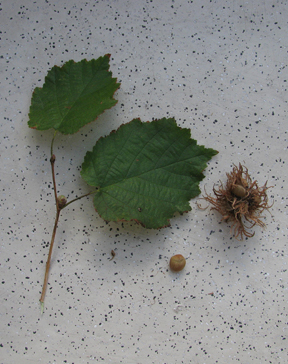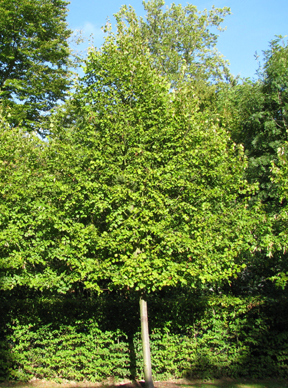
One day you’re walking down your street on your way home, taking in a view that you’ve seen a thousand, no, ten thousand times, when a disturbing thing happens: there among the ever-so-familiar surroundings of sidewalks and buildings, streetlamps and awnings, shade, trunks, and leaves, you see something that you’ve never noticed before.
It’s just a small detail, a spiny husk fallen from the tree, for example, but when you bend down for a closer look you realize that you never knew the tree in your street bore fruit.

You pick it up—or rather I did—and discover that for the past ten years you—or rather I—haven’t been living on a street bordered by linden trees but by something else. Linden trees don’t bear fruit like this, and certainly not in late summer, and certainly not with a spiny husk that contains what turns out to be some kind of nut.
Ten years! How could I not have noticed? I thought something was strange when I stood on my balcony this afternoon and watched the Asian family who occasionally, at about 5:30, just before the garbage truck arrives, go through the garbage cans along the sidewalk. They weren’t going through the garbage today but rather were gathering something beneath the trees. I had quickly forgotten (I took this photo a few days later), however something must have stuck. Later this afternoon, returning home from buying bread at the bakery, I noticed husks on the ground. There were lots of them, beneath all the trees.
How could I have missed them? And for ten years!
One moment you’re walking beneath your lindens—yes, your lindens—on your way to buy bread, and five minutes later, demi baguette in hand, you discover that you live on a street not with lindens but with some kind of nut-bearing trees.

Your life then feels like a fraud. Mine did, at least the part that is supposedly aware of its surroundings, the part that feels at home on a street with linden trees. Lindens are frequent in Paris, including most famously in Place des Vosges and the garden of Palais Royal.
But those aren’t lindens after all. The leaves, I saw upon looking up, though heart-shaped like a linden’s, were serrated, like a scary version of linden leaves. And those spiny husks (photo left) look like something from a horror movie! How could I never have noticed them before?
Earlier in the summer I was doing research on the internet—that free-floating kind of research that I associated with the World Book encyclopedia when I was a kid, during which you forget what you were looking for but find along the way lots of details wish you could hold onto—and came across a man I have come to know as Monsieur Nature.
Mr. Nature knows all about the birds and the bees and the crops and the trees. I wrote to him and eventually enlisted him to lead me on some naturalist wanderings on the edge of the Paris region, particularly in a zone known as the Vexin Français, a regional natural park of villages and farmland north of the Seine on the edge of the Paris region, just before entering Normandy.
In my disturbed state at discovering nuts falling from what I had previously thought to be lindens, I took a close-up photo of a prickly husks, a nut and a leaf and an image of a full tree and sent them to Mr. Nature asking him to help me identify it.

“Salut Gary!,” he responded. “You’re to be excused as an urbanite! Other than the flowering of the catkins that comes at a different season from that of lindens (and that should have set you on a different path héhé…)…”
I’ve translated the above line since his message was in French. For catkins he’d written chatons, which I had to look up in my French-English dictionary. After that I had to look up catkins in my Webster’s. It means “a spicate inflorescence,” which was no help at all.
Mr. Nature went on to tell me that my linden was in fact a noisetier de Byzance, corylus colurna, known in English as a Turkish filbert. He tried to reassure me that my ignorance was excusable by telling me that the leaves of the noisetier de Byzance resemble the linden’s and that both trees often have a pyramidal shape. He added that the Turkish filbert tolerates drought and chalky, alkaline soils, as well as pollution and wind, which made them good city plants. And he informed me that the nuts are edible, which explains the family harvesting them the other day. They are, in fact, hazelnuts.
Mr. Nature sent me to the following website: www.lesarbres.fr/fiche-byzance.php
Here’s one in English: plantfacts.osu.edu/descriptions/0246-332.html

Various websites, I’ve since found, note how the Turkish filbert “resembles a linden from a distance.” (Compare the linden to the right with the filbert at the top of this blog.) But I’ve been walking walk by the trees on my street every day, 2, 4, 6 times a day! And for ten years now!
Not knowing doesn’t bother me so much as not noticing. I had never noticed how serrated the leaves are. I had never even registered that spiky husks fall in late August or early September, let alone that there are hazelnuts inside.
From my window I thought for ten years that I’ve been watching linden leaves bud in April, that I’ve been watching linden leaves’ pale green turn a deep green, that I’ve been watching linden leaves blown by the wind, that I’ve been watching linden leaves turn yellow then brown and then fall. But I haven’t been watching that all, I’ve been watching filbert leaves!
Linden flowers put off a more or less powerful scent when in tiny bloom in early summer and the fact that I had always reasoned that I didn’t smell the scent on my street because mine were of the lesser scented citified kind. It would have been much simpler to reason that they didn’t smell like lindens in early summer because they weren’t lindens at all, but that had never crossed my mind.
Several times now I’ve gone out to the Vexin Français and other greenery with Mr. Nature and have been trying to remember the names of trees, particularly that in French birch is bouleau and beech is hêtre. But it won’t stick. It isn’t a vocabulary problem it’s a natural problem. Botanical names just don’t stay with me.
I’ve repeated those names a dozen times—birch=bouleau, beech= hêtre… birch=bouleau, beech= hêtre… etc. I’ve stared at a single birch for a full three minutes thinking of nothing but bouleau. But still, show me a birch and I’m likely not even to remember that it is a birch, let alone un bouleau.
I know where the ambulatory/déambulatoire is in Notre-Dame, I remember that Henri IV was assassinated in 1610, and I’m pretty good at distinguishing a Pissarro from a Sisley, things that interest me only when I’m in a particularly cultured mood but that truly don’t matter to me.
But I am very attached to trees. In an uninformed way I’m drawn to them. I’m fascinated by the ways in which they, too, live and change and suffer and survive and adapt and blossom and stay serene. I recognize that one of the wonderful things about Paris compared with, say, New York or Rome, is that wherever you go you’ll see a variety of trees: plane trees and horse chestnuts and lindens and, I now know, Turkish filberts—hazelnuts, if you like.
But I’m unlikely to remember their names. They just won’t stick in my non-botanical brain. Still, some kind of awareness remains, some kind of discovery, for having digested the disturbing fact that I no longer live on a street with lindens, I feel, as summer ends, a sense of renewal, as though I’ve moved to a new neighborhood, a new street, where hazelnuts grow, and where filbert leaves will soon be falling.


This is too funny! The exact same thing happened to me! I have the most magnificent tree in my back yard, absolutely huge, and for 5 years never really noticed these husks. I mean, I may have seen one or two, but always thought they were brought by the squirrels from somewhere else because surely a tree of this magnitude would produce enormous amounts of pods if they were from it right? Then this past year we put a patio off our back porch which extended under the tree, and all of the sudden, I started noticing these nut shells (well, noticing meaning i was stepping on them in my bare feet and cursing the squirrels once again for bringing this oddity into my yard!) Only shortly after, to have a friend identify our tree as this Turkish Filbert! Duh! Yes, when i crack open those husks, those are indeed hazelnuts inside. How could I possibly over 5 years never done that!?!?! Shared disbelief! Though despite mine’s size, the production is low and I have to fight the squirrels to get the pods/nuts before they do!
Funny indeed, Carrie. And strange that your was also a Turkish Filbert. There must be something about them that allows them to play mind games with us. Sounds absolutely Twilight-Zonish. Please let me know if anything else odd occurs in the yard. In the meantime, enjoy the hazelnuts.
Gary